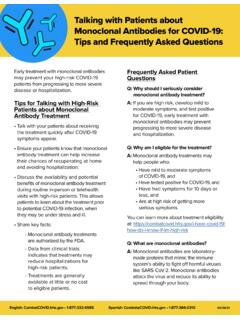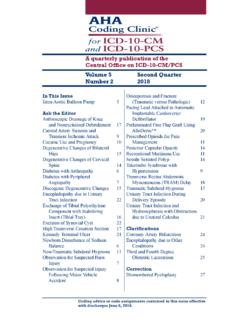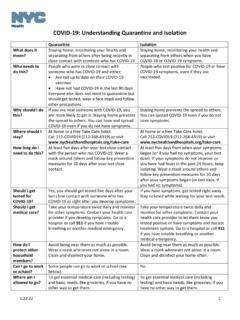Transcription of ANNEX I SUMMARY OF PRODUCT CHARACTERISTICS
1 1 ANNEX I SUMMARY OF PRODUCT CHARACTERISTICS 2 This medicinal PRODUCT is subject to additional monitoring. This will allow quick identification of new safety information. Healthcare professionals are asked to report any suspected adverse reactions. See section for how to report adverse reactions. 1. NAME OF THE MEDICINAL PRODUCT Leqvio 284 mg solution for injection in pre-filled syringe 2. QUALITATIVE AND QUANTITATIVE COMPOSITION Each pre-filled syringe contains inclisiran sodium equivalent to 284 mg inclisiran in ml solution. Each ml contains inclisiran sodium equivalent to 189 mg inclisiran. For the full list of excipients, see section 3. PHARMACEUTICAL FORM Solution for injection (injection).
2 The solution is clear, colourless to pale yellow, and essentially free of particulates. 4. CLINICAL PARTICULARS Therapeutic indications Leqvio is indicated in adults with primary hypercholesterolaemia (heterozygous familial and non-familial) or mixed dyslipidaemia, as an adjunct to diet: in combination with a statin or statin with other lipid-lowering therapies in patients unable to reach LDL-C goals with the maximum tolerated dose of a statin, or alone or in combination with other lipid-lowering therapies in patients who are statin-intolerant, or for whom a statin is contraindicated. Posology and method of administration Posology The recommended dose is 284 mg inclisiran administered as a single subcutaneous injection: initially, again at 3 months, followed by every 6 months.
3 Missed doses If a planned dose is missed by less than 3 months, inclisiran should be administered and dosing continued according to the patient s original schedule. If a planned dose is missed by more than 3 months, a new dosing schedule should be started inclisiran should be administered initially, again at 3 months, followed by every 6 months. treatment transition from monoclonal antibody PCSK9 inhibitors Inclisiran can be administered immediately after the last dose of a monoclonal antibody PCSK9 inhibitor. To maintain LDL-C lowering it is recommended that inclisiran is administered within 2 weeks after the last dose of a monoclonal antibody PCSK9 inhibitor. 3 Special populations Elderly (age 65 years) No dose adjustment is necessary in elderly patients.
4 Hepatic impairment No dose adjustments are necessary for patients with mild (Child-Pugh class A) or moderate (Child-Pugh class B) hepatic impairment. No data are available in patients with severe hepatic impairment (Child-Pugh class C) (see section ). Inclisiran should be used with caution in patients with severe hepatic impairment. Renal impairment No dose adjustments are necessary for patients with mild, moderate or severe renal impairment or patients with end-stage renal disease (see section ). There is limited experience with inclisiran in patients with severe renal impairment. Inclisiran should be used with caution in these patients. See section for precautions to take in case of haemodialysis. Paediatric population The safety and efficacy of inclisiran in children aged less than 18 years have not yet been established.
5 No data are available. Method of administration Subcutaneous use. Inclisiran is for subcutaneous injection into the abdomen; alternative injection sites include the upper arm or thigh. Injections should not be given into areas of active skin disease or injury such as sunburns, skin rashes, inflammation or skin infections. Each 284 mg dose is administered using a single pre-filled syringe. Each pre-filled syringe is for single use only. Inclisiran is intended for administration by a healthcare professional. Contraindications Hypersensitivity to the active substance or to any of the excipients listed in section Special warnings and precautions for use Haemodialysis The effect of haemodialysis on inclisiran pharmacokinetics has not been studied.
6 Considering that inclisiran is eliminated renally, haemodialysis should not be performed for at least 72 hours after inclisiran dosing. Sodium content This medicinal PRODUCT contains less than 1 mmol sodium (23 mg) per dose, that is to say essentially sodium-free . 4 Interaction with other medicinal products and other forms of interaction Inclisiran is not a substrate for common drug transporters and, although in vitro studies were not conducted, it is not anticipated to be a substrate for cytochrome P450. Inclisiran is not an inhibitor or inducer of cytochrome P450 enzymes or common drug transporters. Therefore, inclisiran is not expected to have clinically significant interactions with other medicinal products. Based on the limited data available, clinically meaningful interactions with atorvastatin, rosuvastatin or other statins are not expected.
7 Fertility, pregnancy and lactation Pregnancy There are no or limited amount of data from the use of inclisiran in pregnant women. Animal studies do not indicate direct or indirect harmful effects with respect to reproductive toxicity (see section ). As a precautionary measure, it is preferable to avoid the use of inclisiran during pregnancy. Breast-feeding It is unknown whether inclisiran is excreted in human milk. Available pharmacodynamic/toxicological data in animals have shown excretion of inclisiran in milk (see section ). A risk to newborns/infants cannot be excluded. A decision must be made whether to discontinue breast-feeding or to discontinue/abstain from inclisiran therapy, taking into account the benefit of breast-feeding for the child and the benefit of therapy for the woman.
8 Fertility No data on the effect of inclisiran on human fertility are available. Animal studies did not show any effects on fertility (see section ). Effects on ability to drive and use machines Leqvio has no or negligible influence on the ability to drive and use machines. Undesirable effects SUMMARY of the safety profile The only adverse reactions associated with inclisiran were adverse reactions at the injection site ( ). Tabulated list of adverse reactions Adverse reactions are presented by system organ class (Table 1). Frequency categories are defined as: very common ( 1/10); common ( 1/100 to <1/10); uncommon ( 1/1,000 to <1/100); rare ( 1/10,000 to <1/1,000); very rare (<1/10,000) and not known (cannot be estimated from the available data).
9 Table 1 Adverse reactions reported in patients treated with inclisiran System organ class Adverse reaction Frequency category General disorders and administration site conditions Adverse reactions at the injection site1 Common 1 See section Description of selected adverse reactions 5 Description of selected adverse reactions Adverse reactions at the injection site Adverse reactions at the injection site occurred in and of inclisiran and placebo patients, respectively, in the pivotal studies. The proportion of patients in each group who discontinued treatment due to adverse reactions at the injection site was and , respectively. All of these adverse reactions were mild or moderate in severity, transient and resolved without sequelae.
10 The most frequently occurring adverse reactions at the injection site in patients treated with inclisiran were injection site reaction ( ), injection site pain ( ), injection site erythema ( ), and injection site rash ( ). Special populations Elderly Of the 1,833 patients treated with inclisiran in the pivotal studies, 981 (54%) were 65 years of age or older, while 239 (13%) were 75 years of age or older. No overall differences in safety were observed between these patients and younger patients. Immunogenicity In the pivotal studies 1,830 patients were tested for anti-drug antibodies. Confirmed positivity was detected in (33/1,830) of patients prior to dosing and in (90/1,830) of patients during the 18 months of treatment with inclisiran.












